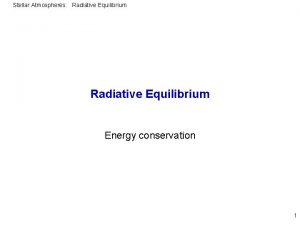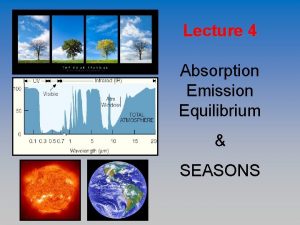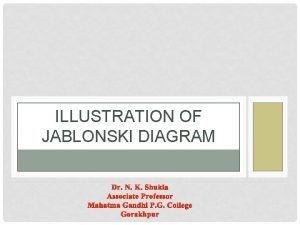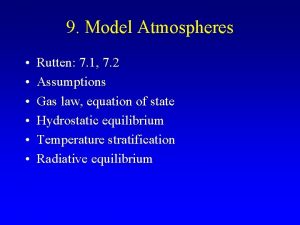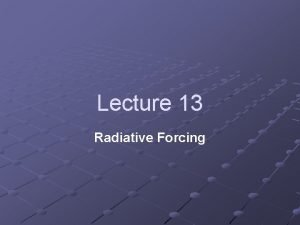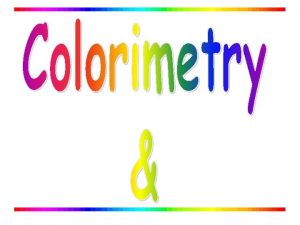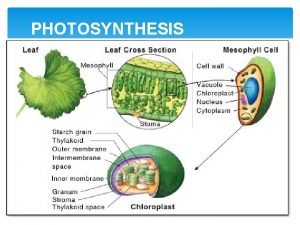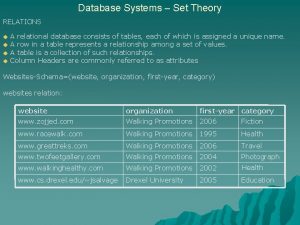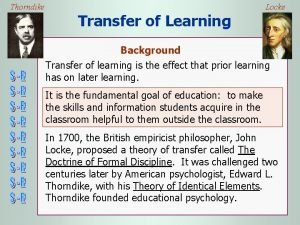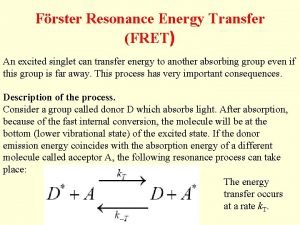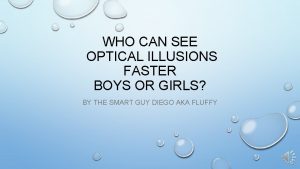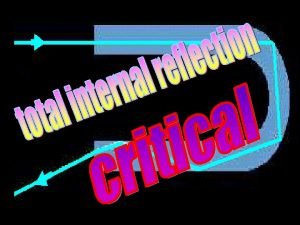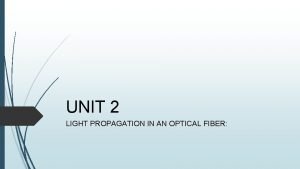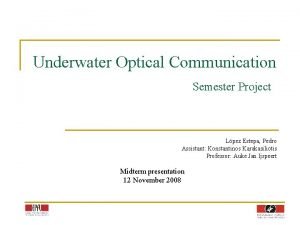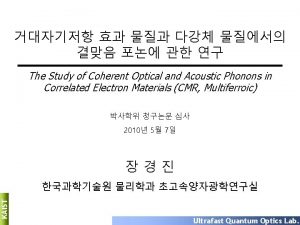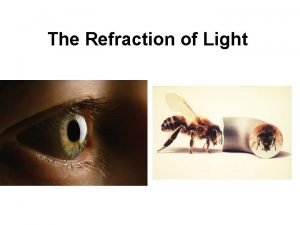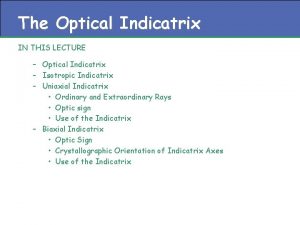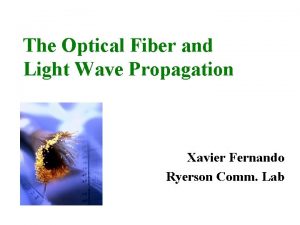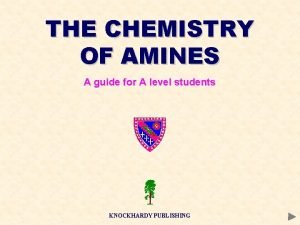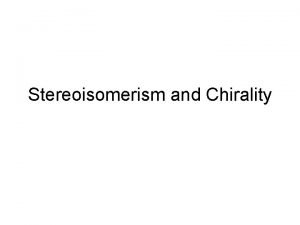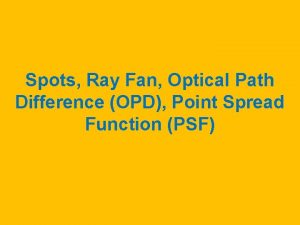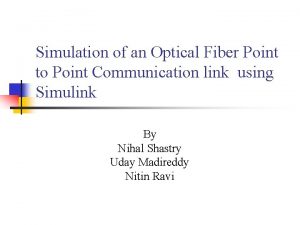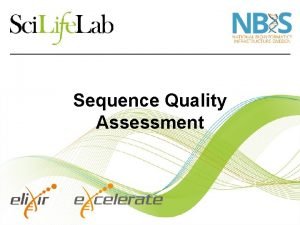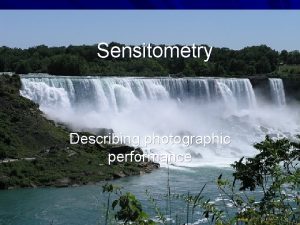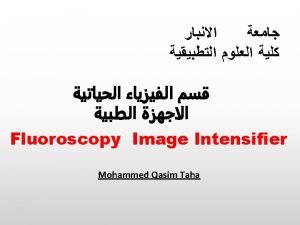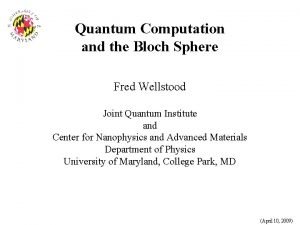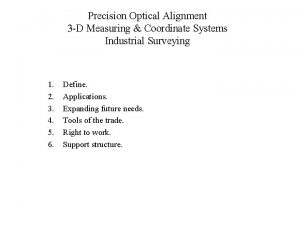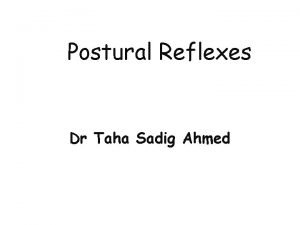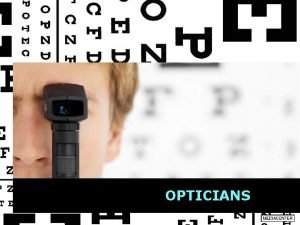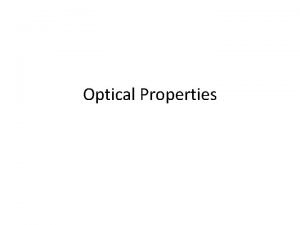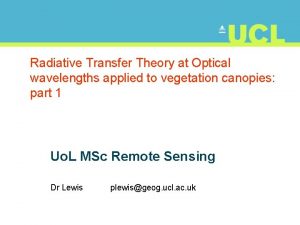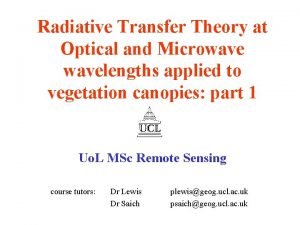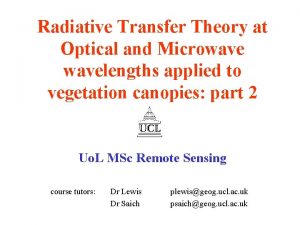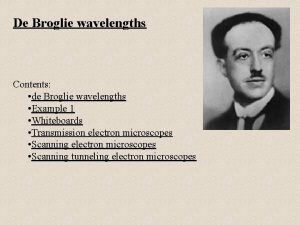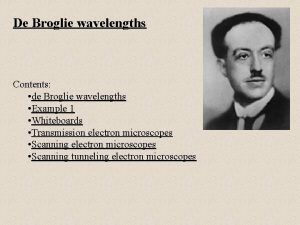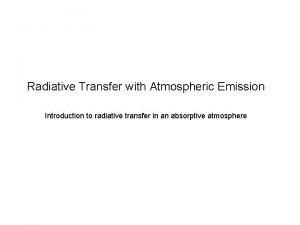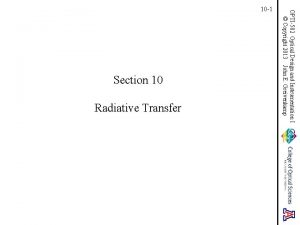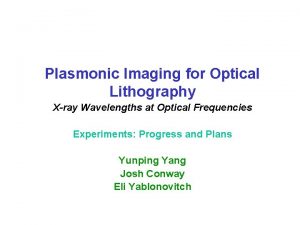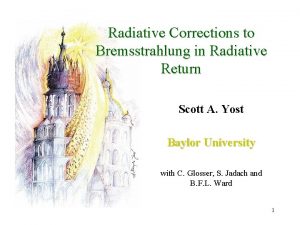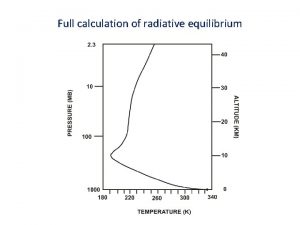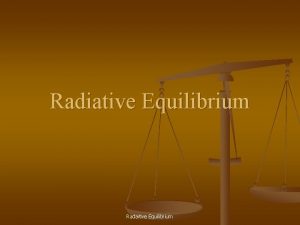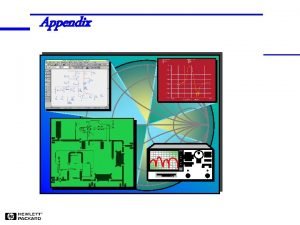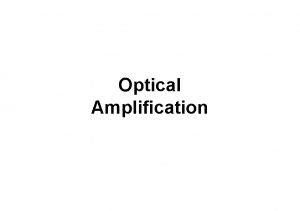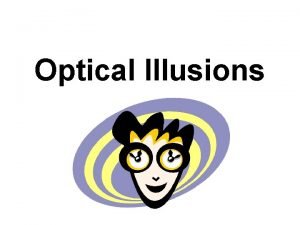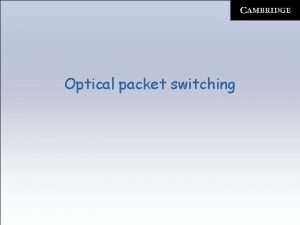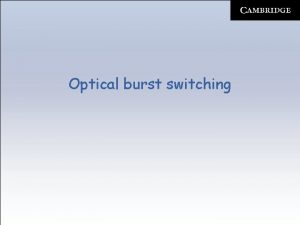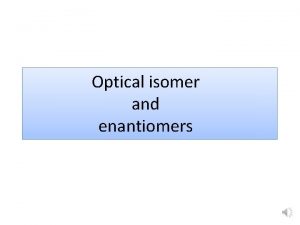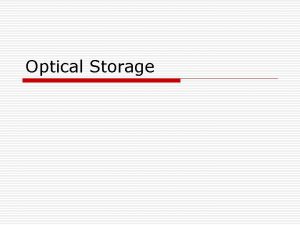Radiative Transfer Theory at Optical wavelengths applied to






































- Slides: 38

Radiative Transfer Theory at Optical wavelengths applied to vegetation canopies: part 1 Uo. L MSc Remote Sensing Dr Lewis plewis@geog. ucl. ac. uk

Aim of this section • Introduce RT approach as basis to understanding optical and microwave vegetation response • enable use of models • enable access to literature

Scope of this section • Introduction to background theory – RT theory – Wave propagation and polarisation – Useful tools for developing RT • Building blocks of a canopy scattering model – canopy architecture – scattering properties of leaves – soil properties

Associated practical and reading • Reading – Course notes for this lecture – Reading list

Why build models? • Assist data interpretation • calculate RS signal as fn. of biophysical variables • Study sensitivity • to biophysical variables or system parameters • Interpolation or Extrapolation • fill the gaps / extend observations • Inversion • estimate biophysical parameters from RS • aid experimental design • plan experiments


Radiative Transfer Theory • Applicability – heuristic treatment • consider energy balance across elemental volume – assume: • no correlation between fields – addition of power not fields • no diffraction/interference in RT – can be in scattering – develop common (simple) case here

Radiative Transfer Theory • Case considered: – horizontally infinite but vertically finite plane parallel medium (air) embedded with infinitessimal oriented scattering objects at low density – canopy lies over soil surface (lower boundary) – assume horizontal homogeneity • applicable to many cases of vegetation

Building blocks for a canopy model • Require descriptions of: – canopy architecture – leaf scattering – soil scattering

Canopy Architecture • 1 -D: Functions of depth from the top of the canopy (z).

Canopy Architecture • 1 -D: Functions of depth from the top of the canopy (z). 1. Vertical leaf area density (m 2/m 3) 2. the leaf normal orientation distribution function (dimensionless). 3. leaf size distribution (m)

Canopy Architecture • Leaf area / number density – LAI (one-sided) m 2 leaf per m 3

Canopy Architecture • Leaf Angle Distribution

Leaf Angle Distribution • Archetype Distributions: · planophile · erectophile · spherical · plagiophile · extremophile

Leaf Angle Distribution • Archetype Distributions:

Leaf Dimension • RT theory: infinitessimal scatterers – without modifications (dealt with later) • In optical, leaf size affects canopy scattering in retroreflection direction – ‘roughness’ term: ratio of leaf linear dimension to canopy height also, leaf thickness effects on reflectance /transmittance

Canopy element and soil spectral properties • Scattering properties of leaves – scattering affected by: • Leaf surface properties and internal structure; • leaf biochemistry; • leaf size (essentially thickness, for a given LAI).

Scattering properties of leaves • Leaf surface properties and internal structure optical Specular from surface Smooth (waxy) surface - strong peak hairs, spines - more diffused

Scattering properties of leaves • Leaf surface properties and internal structure optical Diffused from scattering at internal air-cell wall interfaces Depends on total area of cell wall interfaces Depends on refractive index: varies: 1. 5@400 nm 1. 3@2500 nm

Scattering properties of leaves • Leaf surface properties and internal structure optical More complex structure (or thickness): - more scattering - lower transmittance - more diffuse

Scattering properties of leaves • Leaf biochemstry

Scattering properties of leaves • Leaf biochemstry

Scattering properties of leaves • Leaf biochemstry

Scattering properties of leaves • Leaf biochemstry

Scattering properties of leaves • Leaf water

Scattering properties of leaves • Leaf biochemstry – pigments: chlorophyll a and b, a-carotene, and xanthophyll • absorb in blue (& red for chlorophyll) – absorbed radiation converted into: • heat energy, flourescence or carbohydrates through photosynthesis

Scattering properties of leaves • Leaf biochemstry – Leaf water is major consituent of leaf fresh weight, • around 66% averaged over a large number of leaf types – other constituents ‘dry matter’ • cellulose, lignin, protein, starch and minerals – Absorptance constituents increases with concentration • reducing leaf reflectance and transmittance at these wavelengths.

Scattering properties of leaves • Optical Models – flowering plants: PROSPECT

Scattering properties of leaves • Optical Models – flowering plants: PROSPECT

Scattering properties of leaves • leaf dimensions – optical • increase leaf area for constant number of leaves increase LAI • increase leaf thickness - decrease transmittance (increase reflectance)

Scattering properties of soils • Optical and microwave affected by: – soil moisture content – soil type/texture – soil surface roughness.

soil moisture content • Optical – effect essentially proportional across all wavelengths • enhanced in water absorption bands

soil texture/type • Optical – relatively little variation in spectral properties – Price (1985): • PCA on large soil database • 99. 6% of variation in 4 PCs – Stoner & Baumgardner (1982) defined 5 main soil types: • • • organic dominated minimally altered iron affected organic dominated iron dominated

Soil roughness effects • Simple models: – as only a boundary condition, can sometimes use simple models • e. g. Lambertian • e. g. trigonometric (Walthall et al. , 1985)

Soil roughness effects • Rough roughness: – optical surface scattering • clods, rough ploughing – use Geometric Optics model (Cierniewski) – projections/shadowing from protrusions

Soil roughness effects • Rough roughness: – optical surface scattering • Note backscatter reflectance peak (‘hotspot’) • minimal shadowing • backscatter peak width increases with increasing roughness

Soil roughness effects • Rough roughness: – volumetric scattering • consider scattering from ‘body’ of soil – particulate medium – use RT theory (Hapke - optical) – modified for surface effects (at different scales of roughness)

Summary • Introduction – Examined rationale for modelling – discussion of RT theory – Scattering from leaves • Canopy model building blocks – canopy architecture: area/number, angle, size – leaf scattering: spectral & structural – soil scattering: roughness, type, water
 Radiative equilibrium temperature
Radiative equilibrium temperature Radiative equilibrium temperature
Radiative equilibrium temperature Jablonsky diagram
Jablonsky diagram Radiative equilibrium temperature
Radiative equilibrium temperature Radiative forcing definition
Radiative forcing definition Color wavelengths
Color wavelengths Electromagnetic spectrum
Electromagnetic spectrum Different wavelengths
Different wavelengths Transfer transfer
Transfer transfer Set theory in database
Set theory in database Theory of probability in surveying
Theory of probability in surveying Applied learning theory
Applied learning theory Theories of learning thorndike
Theories of learning thorndike Transfer of learning theory
Transfer of learning theory Transfer of learning theory
Transfer of learning theory Energy transfer theory
Energy transfer theory Optical illusions science fair projects
Optical illusions science fair projects When light travels from an optically denser medium
When light travels from an optically denser medium The angle of acceptance cone is twice the *
The angle of acceptance cone is twice the * Underwater optical control
Underwater optical control Optical vs acoustic phonons
Optical vs acoustic phonons In a curved optical fiber light
In a curved optical fiber light Optical indicatrix
Optical indicatrix Skew rays in optical fiber
Skew rays in optical fiber Physical properties of amines
Physical properties of amines Precision optical blanks
Precision optical blanks What is a constitutional isomer
What is a constitutional isomer Zemax ray fan
Zemax ray fan Optical fiber simulation
Optical fiber simulation Alientrimmer
Alientrimmer Optical density of gross fog
Optical density of gross fog Northern optical ordinarily sells the x-lens for $50
Northern optical ordinarily sells the x-lens for $50 Optical coupling in fluoroscopy
Optical coupling in fluoroscopy Bloch sphere
Bloch sphere Precision optical alignment service
Precision optical alignment service Decerebrate posture
Decerebrate posture Specsavers prelude
Specsavers prelude Optical transport module
Optical transport module What is an optical property
What is an optical property
